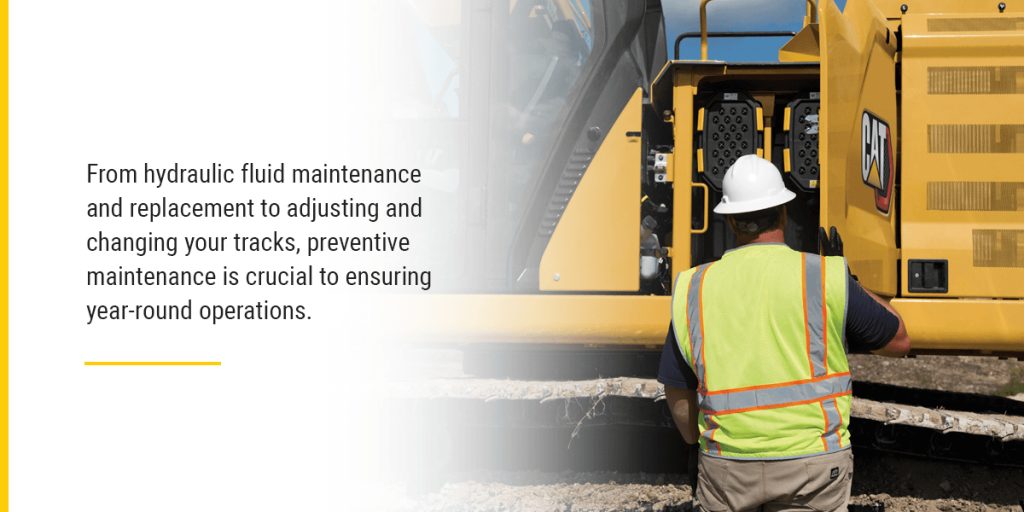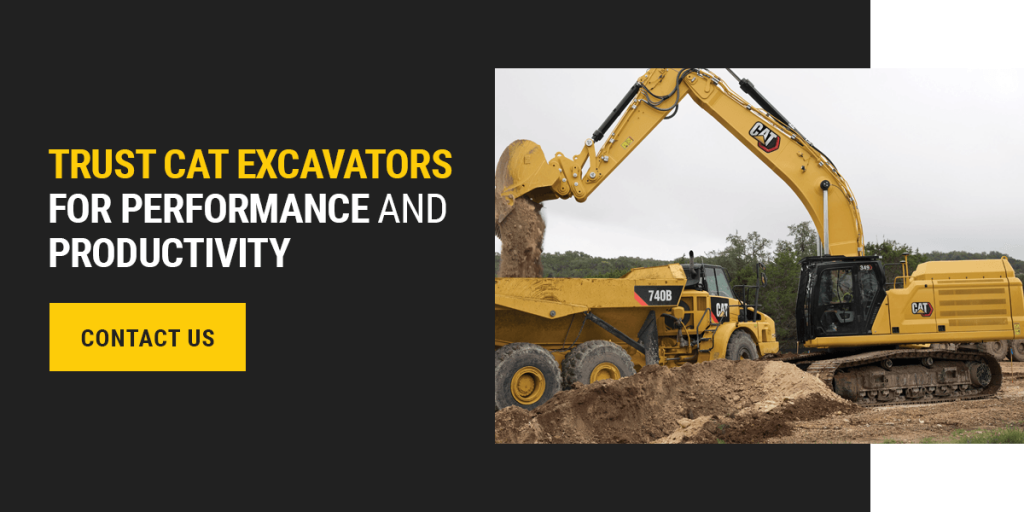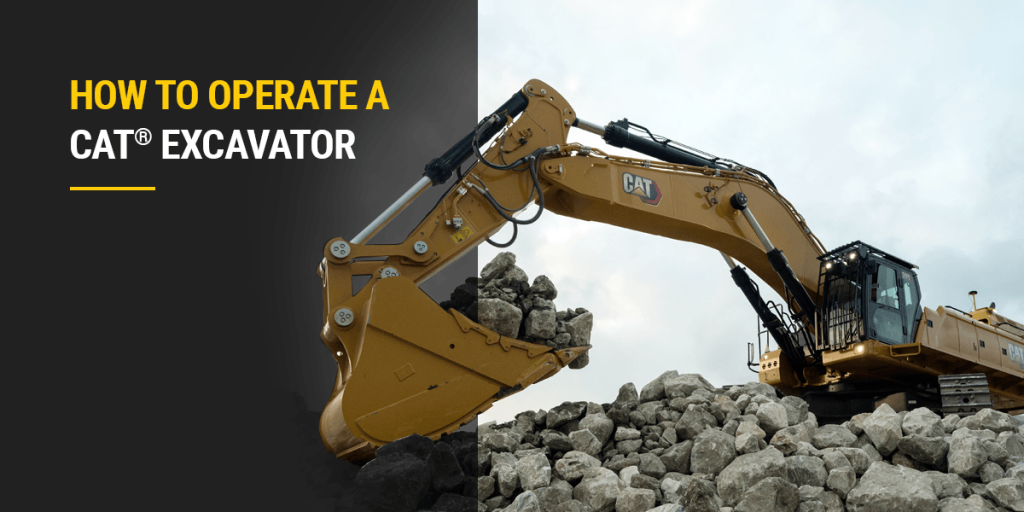
Jump To Sections:
- What Is an Excavator Used For?
- How Do You Operate an Excavator?
- How to Transport an Excavator
- How To Clean an Excavator
- How to Maintain an Excavator
- Trust Cat Excavators
Like all earthmoving equipment, excavators play a key role in construction and landscaping. While excavators are commonly associated with digging foundations, they’re truly versatile machines with a range of possibilities. Thanks to dozens of compatible work tools, excavators can perform numerous general and specialized work site tasks.
If you’re new to excavators, this guide will teach you how to operate an excavator, as well as how to transport and maintain your machine properly and safely.
What Is an Excavator Used For?
As heavy-duty construction equipment, excavators are designed to face rugged challenges, including digging, drilling and churning up hard earth and rock. They’re large, stable and durable machines up to any tough construction job. Since most excavators come equipped with tracks, these machines can easily traverse uneven ground, remaining stable with their wide weight distribution.
Below are some specific details on how to use an excavator:
How to Dig With an Excavator
What does an excavator do? Primarily, excavators are meant for digging. As earthmovers, they penetrate soil, rock, dirt, clay and other materials, scooping it up with their front bucket attachment and depositing it away from the newly dug hole. Excavators come equipped with a heavy-duty bucket, which is attached to the stick-and-boom operating arm of the machine.
Inside the cab, the operator is able to rotate the machine, lift the boom and articulate the arm to position the bucket over the front idlers appropriately for digging and depositing. Digging over the sprockets puts extra stress on the final drives that propel the tracks and can lead to pre-mature bearing failure. Whether you’re digging a hole for a foundation, a septic field, a ditch or a pool, an excavator is the best machine for the job.
Understanding your excavator controls is crucial to digging holes or trenches with accuracy. When you’re trying to create a level surface and don’t own leveling or grading equipment, you can use your excavator bucket to finish the area.
Knowing how to dig level with an excavator is a valuable trait, and it takes some practice. You’ll want to position your bucket at the uppermost level of the dirt you’re moving and parallel to the grade you want to achieve. Then, you can begin swinging your boom side to side and displacing soil in overlapping passes, gradually getting deeper until you reach your desired grade.
How to Backfill With an Excavator
The flipside of digging is backfilling — the process of reinforcing the ground by packing in holes and smoothing out the surface so it can support a structure. During backfilling, excavator operators use the displaced soil from the dug hole to fill in around the structure or to cover the hole completely. Tightly compacted backfill prevents the ground from shifting underneath the structure.
Backfilling is done when building a foundation or to cover up trenched ground where pipe, cable and irrigation lines were installed. The backfilling technique is done in layers to help further compact the soil and reinforce the stability of the structure. Keep in mind that excavators are designed to pull bucketed material towards the cab, so aggressive side dozing can lead to structural failure over time.
How to Clear Trees With an Excavator
In construction, landscaping and forestry applications, tree felling is a normal part of resource-harvesting, lot clearing and land management. Felled trees leave behind stumps, which need to be unearthed and removed to prepare for construction or to make room for replanting.
Excavators are the most viable equipment for completely and efficiently removing large stumps. With an excavator bucket, an operator can dig around an old stump and unearth it effortlessly. When clearing stumps using an excavator bucket, operators can also try to preserve as much fill as possible in the bucket as they deposit the old stump aside. Attaching an excavator thumb work tool to your bucket will help grip stumps and their roots as you remove them. A durable three over two pin on or pin grabber grapple provides the ultimate stump removal. Operators can remove and manipulate stumps to get excess dirt and stone out prior to tub grinding to lower grinder repair costs significantly.
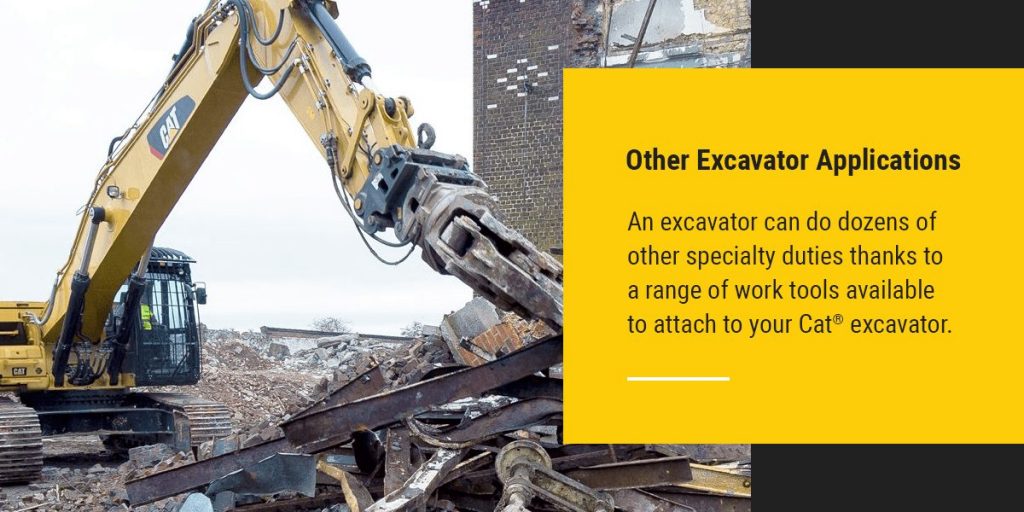
Other Excavator Applications
In addition to digging, backfilling and uprooting stumps, what else does an excavator do? An excavator can do dozens of other specialty duties thanks to a range of work tools available to attach to your Cat® excavator. Changing out your skid steer attachments is quick and easy, but the specific instructions depends on whether it has a manual or powered quick coupler. Here are a few other applications you can accomplish with a Cat excavator:
- Drilling holes for footings, post holes or tree and shrub plantings with an auger.
- Breaking up concrete or rock during demolition or quarry mining with a hammer or shears.
- Moving large boulders or objects with grapple.
- Compacting and smoothing out road materials with a compactor.
- Clearing land or brush cuttings with a rake.
- Crushing, cutting and pulverizing with a multi-processor.
- Churning up topsoil in frozen ground with a ripper.
Consult the H.O. Penn representatives for expertise in choosing the best excavator attachment for your job.
How Do You Operate an Excavator?
Operating an excavator takes patience and practice. As with all heavy equipment operations, running an excavator also requires vigilance. Operating heavy machinery is a major responsibility, and staying alert to your surroundings is key to keeping yourself, others and surrounding structures safe.
Depending on the size of the excavator, your level of experience and the type of job you’re working on, becoming certified as a heavy equipment operator may be worthwhile, if not required. If you’re new to running an excavator, there are some operating basics that are universal to all excavators, including those manufactured by Caterpillar.
Below are some of the key instructions you need on how to run an excavator properly:
How to Operate Excavator Controls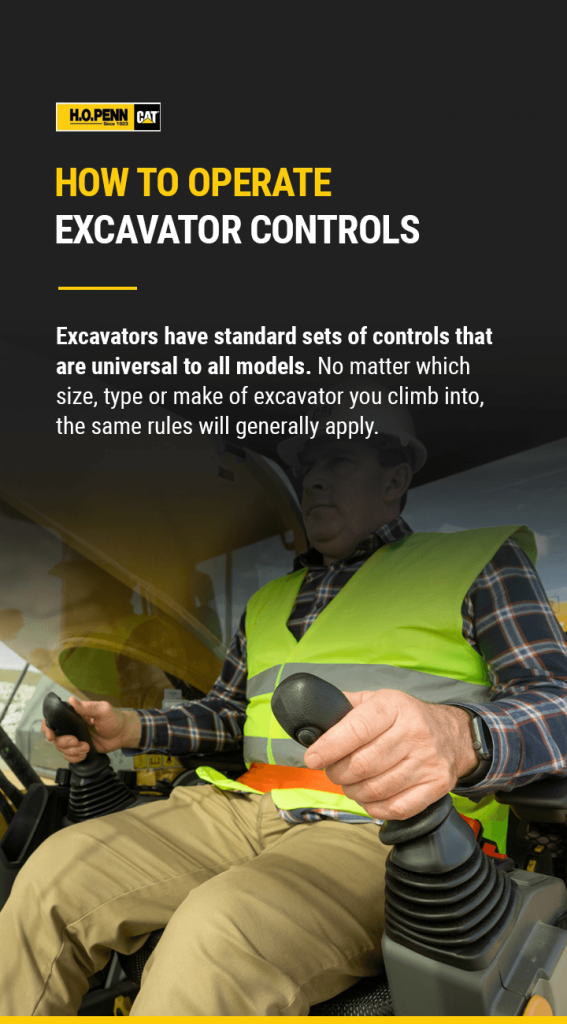
Excavators have standard sets of controls that are universal to all models. No matter which size, type or make of excavator you climb into, the same rules will generally apply. The first step in learning how to run an excavator is becoming familiar with its controls. Excavators typically have one of two control patterns — ISO controls and SAE controls. ISO controls are generally considered to be an excavator control design and will be more common, while SAE controls are known as backhoe patterns.
Here’s a deeper look at your possible control configurations:
- ISO controls: The left-hand joystick swings left and right, as well as moves the stick boom forward and back. The right-hand joystick raises and lowers the main boom up and down, as well as dumps or closes the bucket.
- SAE controls:The left-hand joystick swings left and right, as well as raises and lowers the main boom up and down. The right-hand joystick moves the stick boom forward and back, as well as dumps or closes the bucket.
Before running an excavator, it’s important to familiarize yourself with the unique model you’re using to better understand its control patterns, which you can learn more about in your Operation and Maintenance Manual (OMM). Your manual will also tell you whether and how you can switch your controls to your desired pattern. Excavators often have panels underneath the seat, within the cab’s floor or on the cab’s exterior. These panels contain a locking nut and a lever you can use to change the controls. The process to switch your control patterns is fairly straightforward and will take just a few minutes to complete.
How to Start a Cat Excavator
Before starting a Cat excavator, there are a few steps to take to ensure safe operation:
- Conduct a walk-around. Inspect the machine and tracks and take notice of large debris, obstacles or hazards nearby.Look for loose or missing hardware, linkage pins moving out of bores.
- Enter the machine following the three points of contact rule.
- Adjust your ergonomic settings. Both the seat and armrest should be at the right position and height for your body.
- Fasten your seat belt.
- Ensure the hydraulic control is in the raised position. Check that the joysticks are in neutral.
- Check your surroundings one more time.
- Set the throttle to a low idle before starting the engine.
After following the above steps, you can start the Cat excavator and begin operating. Consult your OMM for specific details on best practices for starting your model of Cat excavator.
How to Drive a Cat Excavator
You have two options for how to drive an excavator. You can either drive the excavator using the foot pedals or the hand controls. For safety purposes, you want to only be traveling or digging at any given time. Until you develop expertise operating an excavator, don’t try to dig and drive at once.
Each track has an independent control, meaning you can leave one track still while you move the other track forward or back. Letting off on one pedal and engaging the other allows you to steer the excavator in the direction you’re headed. To put the excavator in reverse, just push the foot pedals with your heels or move the hand controls toward you, and the machine will back up.
Driving an excavator also depends on the grade of the terrain. When climbing up a hill, position the idlers at the back of the tracks to ensure the weight is primarily in the front. When descending a hill, the opposite is true. Position the idlers at the front of the tracks to keep the weight in the back. If the excavator has two speed travel, always use the slow position with the bucket or stick facing downhill, close to the ground, to act as a brake if the machine slides.
How Does an Excavator Rotate?
Modern excavators are able to rotate a full 360 degrees. The full-turn ability permits the operator to position the cab at any angle above the tracks. Being able to complete a full rotation is useful when digging or lifting at the front of the excavator and depositing soil behind it. Operators can do so without having to reposition the tracks.
An excavator cab is able to make a full 360-degree rotation because of its rotary unions — devices that supply hydraulic fluid to the rotating parts radially, allowing them to operate independently of the stationary base. Essentially, the cab of an excavator pivots on a spool that’s powered by its base.
To rotate an excavator’s stick and boom, you use your left-hand joystick no matter which control pattern your machine is in. You should always try to position the cab directly over the tracks when digging. This allows the machine to remain in the most stable position possible.
Also, the Cat® Tiltrotators for excavators provide 360-degree rotation and 40-degree tilting action side-to-side, allowing the machine to reach more work areas from a single position.
Operating Mini Excavators
Mini excavators are versatile pieces of equipment that offer improved accessibility across the work site to keep your projects rolling smoothly. These lightweight solutions are easy to maneuver and gentler on soil while still delivering enough power to tackle trenching, plowing and digging projects.
Fortunately, these machines are extremely easy and straightforward to operate, making it a seamless transition if you’re coming from a standard-size excavator. They’re fairly similar to large models and rely on many of the same controls and components, including the sticks and joysticks, throttle, blade, boom, cab, bucket and more. Though you should pursue further training on the specific piece of equipment you intend to use, the following covers the basics of how to operate a mini excavator:
- Read through the OMM and inspect your machine.
- Maintain three points of contact and use any required safety mechanisms while getting on board.
- Start the excavator and pull the safety lock.
- Set your engine speed.
- Use the two joysticks to control boom, bucket curl and swing.
How to Transport an Excavator
How to transport an excavator depends on its size and weight. Knowing how to transport an excavator safely is as important as knowing how to operate it. To ensure you can adequately transport an excavator, you need the right towing equipment. The trailer needs to be able to withstand the excavator’s weight, and the platform needs to be large enough to ensure there’s no excessive overhang.
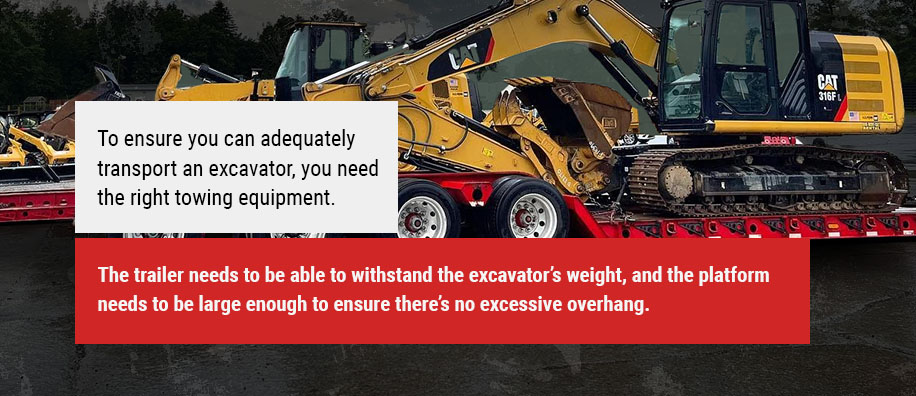
It’s also important to factor in any attachment weight to the trailer’s hauling capacity. Make sure to get a trailer that’s rated at a much higher capacity than the machine itself to accommodate additional weight from work tools.
How to Haul an Excavator
Hauling an excavator requires following proper steps to secure the machine to the trailer. Excavators generally have front and rear tie-down points. Secure the excavator to the trailer using chains threaded through these tie-down points. Check your OMM for details on how to properly secure your excavator.
When in transit, always ensure the boom, arm, bucket and blade are in the lowered position, pointing downward toward the trailer floor. Make sure that the undercarriage is free of mud and debris before transport.
How to Unload an Excavator
Unloading an excavator safely requires you to follow key safety protocols to mitigate hazards and reduce the risk of accidents and injuries. To safely unload an excavator, follow these safety instructions:
- Ensure the designated unloading area is level and clear of hazards.
- Lower the ramp and position it securely. Make sure it’s clear of debris.
- With a spotter, do a walk-around, ensuring the load hasn’t shifted during transport.
- Release the load by removing tie-downs one at a time.
- Back the excavator down the ramp slowly. Position the spotter so they aren’t in the way of the excavator but can still be in sight of the operator.
- Never unload over the side of the trailer!
Once the excavator has been unloaded, you may want to do a final inspection of the equipment as well as the trailer.
How to Clean an Excavator
Cleaning an excavator is part of routine maintenance that increases the machine’s service life and reduces the cost of repairs and replacements. To do so, you need powerful pressure washing equipment that can slice through caked-on mud and dirt. The high-pressure streams of water from a pressure washer allow you to precisely target tight spots, breaking up grime and gunk without needing to use a hand brush.
In addition to using a pressure washer, you’ll also need to apply a degreasing agent to help facilitate the removal of stubborn grease.
How to Clean Excavator Tracks
To keep your excavator tracks in good working condition, it’s important to clean them regularly. After each use, you can quickly brush off the tracks by raising one track with your boom and running the track forward and back, allowing dirt to fall away. Repeat on the other side.
Once you’ve removed the bulk of the dirt, you can manually remove more dirt with a shovel. With the blade facing down, scrape along the tracks to remove dirt. This technique works on dust, mud, debris, ice and snow.
Temperatures below freezing requires extra care when cleaning excavator tracks. Machines need to be parked on timber or old tires to prevent being frozen to surfaces. Always make sure that the tracks are free to rotate by putting down pressure to break the pads free of the surface. Never try to rock the machine with the travel pedal to break it loose.
How to Maintain an Excavator
Routine excavator maintenance prevents costly downtime and unexpected failures. From hydraulic fluid maintenance and replacement to adjusting and changing your tracks, preventive maintenance is crucial to ensuring year-round operations.
Below are some critical excavator maintenance instructions to follow:
- How to check hydraulic fluid on an excavator: Always check hydraulic fluids before operating as part of your daily walk-around inspection. Ensure the stick is in the service position. Access the hydraulic fluid gauge in the side compartment and determine whether the fluid level is at or below the indicated level.
- How to check for leaks: Leaky hydraulic cylinders pose multiple risks, creating environmental issues by allowing oil to escape and opening the hydraulic system to debris that can cause significant damage. It’s wise to regularly check for signs of fluid around your machine, listen for strange sounds during filling and stay on the lookout for increasing fluid usage trends. Cylinder leaks should be repaired immediately!
- How to add hydraulic fluid to an excavator: Regularly check your hydraulic oil level indicator using a dipstick or sight gauge. After your engine has cooled off and your work area is clean, remove the plug and use a funnel to add the Cat-recommended hydraulic oil to a safe operating range. This process should happen every 2,000 hours in operation, while you should generally check your fluids every eight to 10 hours.
- How to adjust tracks on an excavator: To prevent excessive undercarriage wear, you need to make sure your tracks are set at the appropriate tension. To tighten sagging tracks, first, raise one track off the ground using the boom. Starting with the middle roller, measure the distance from the track. Add grease using your grease gun until the track is tight enough at that roller. Carry on with the other rollers as necessary. Repeat on the other side. Never over tighten the tracks.
- How to change excavator tracks: To replace your excavator tracks, raise one track off the ground using the boom and remove the idler to give the track slack. Remove the nut and pry off the old track using a lever. Lower the machine and lift the new track onto the sprocket and carrier roller. Lift the machine again and push the track into place, adjusting the tension before moving to the other side.
For exact instructions on these maintenance tips and more, see your OMM for details on servicing and maintaining your model of Cat excavator. A general rule of thumb if you are using a hydro mechanical tool is to change hydraulic oil at ½ the recommended interval.
Trust Cat Excavators for Performance and Productivity
Cat excavators are built for high-performance and optimum productivity in construction, landscaping and more. For all your questions about excavators and earthmoving equipment, trust the experts at H.O. Penn. With a wide selection of new and used Cat excavators, you’ll find the right machine for the job.
Contact us online for your Cat excavator needs, or call us at 1-845-448-0018 for more information. Visit one of our locations throughout New York and Connecticut and in Holtsville, Bronx, Newington, Poughkeepsie, Bloomingburg and Medford to view our selection of Cat 300 series excavators in person.

